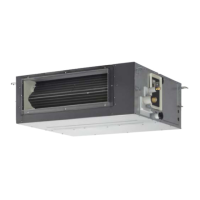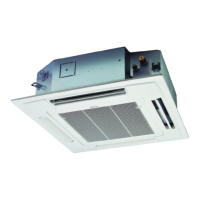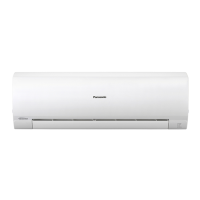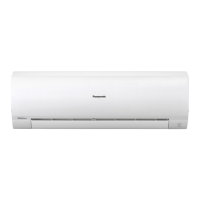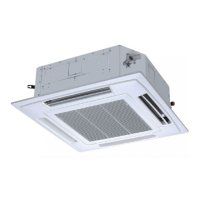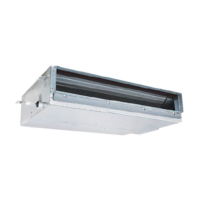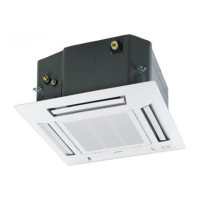29
(2) Ensure that the drain pipe has a downward gradient of
1/100 or more and that there are no water traps.
(3) Provide insulation for the drain pipe.
(4) After the drain piping is completed, pour water into the
drain pan to check that the water drains smoothly.
(5) Remove any dust or debris in the drain pan so that the
pipe is not clogged.
Fig. 3-115
3-33. Installing the Remote Controller
A remote controller (optional wired remote controller) can be
mounted in the indoor unit (Floor Standing type).
(1) Remove the cover of the optional wired remote controller.
(Fig. 3-116)
Fig. 3-116
To remove the cover from the remote controller, insert a
screwdriver between the cover and the controller as shown in
the figure above, and pry off the cover.
(2) Remove the front panel. Remove the screws and fixture.
(Fig. 3-117)
(3) Place the remote controller into the space in the unit
as shown in Fig. 3-117. Assemble the lead wires of the
remote controller to its rear side center and route them to
the lead wire guide.
Fig. 3-117
(4) Secure the fixture using the supplied screws.
Drain hose (supplied) Drain insulator (supplied)
Vinyl clamp
(supplied)
Hose band
(supplied)
Insulating tape
(supplied)
Hard PVC pipe
O.D. 25 mm
(field supply)
Vinyl clamps
(supplied)
Drain hose insulator
(field supply)
Lead wire guide
Remote
controller
Screw
Fixture
4. ELECTRICAL WIRING
4-1. General Precautions on Wiring
(1) Before wiring, confirm the rated voltage of the unit as
shown on its nameplate, then carry out the wiring closely
following the wiring diagram.
(2) Provide a power outlet to be used exclusively for each
unit, and a power supply disconnect and circuit breaker for
overcurrent protection should be provided in the exclusive
line.
(3) To prevent possible hazards from insulation failure, the unit
must be grounded.
(4) Each wiring connection must be done in accordance with
the wiring system diagram. Wrong wiring may cause the
unit to misoperate or become damaged.
(5) Do not allow wiring to touch the refrigerant tubing,
compressor, or any moving parts of the fan.
(6) Unauthorized changes in the internal wiring can be very
dangerous. The manufacturer will accept no responsibility
for any damage or misoperation that occurs as a result of
such unauthorized changes.
(7) Regulations on wire diameters differ from locality to
locality. For field wiring rules, please refer to your LOCAL
ELECTRICAL CODES before beginning.
You must ensure that installation complies with all relevant
rules and regulations.
(8) To prevent malfunction of the air conditioner caused by
electrical noise, care must be taken when wiring as
follows:
● The remote control wiring and the inter-unit control wiring
should be wired apart from the inter-unit power wiring.
● Use shielded wires for inter-unit control wiring between units
and ground the shield on both sides.
(9) If the power supply cord of this appliance is damaged,
it must be replaced by a repair shop appointed by the
manufacturer, because special-purpose tools are required.
4-2. Recommended Wire Length and Wire Diameter
for Power Supply System
Indoor unit
Type
(B) Power supply
Time delay fuse or
circuit capacity
2.5 mm
2
K1 Max. 150 m 10 – 16A
D1, L1, P1, R1 Max. 130 m 10 – 16A
Control wiring
(C) Inter-unit (between
outdoor and indoor
units) control wiring
(D) Remote control wiring
0.75 mm
2
(AWG #18)
Use shielded wiring*
0.75 mm
2
(AWG #18)
Max. 1,000 m Max. 500 m
(E) Control wiring for group
control
(F) Inter-outdoor unit control
wiring
0.75 mm
2
(AWG #18) 0.75 mm
2
(AWG #18)
Use shielded wiring
Max. 200 m (Total) Max. 300 m
NOTE
* With ring-type wire terminal.
PanaIndoor-337012Eng.indb29PanaIndoor-337012Eng.indb29 2012/03/2116:20:502012/03/2116:20:50

